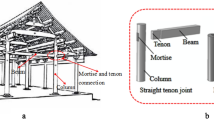Abstract
We studied the effect of loose tenon dimensions on stress and strain distributions in T-shaped mortise and loose tenon (M<) furniture joints under uniaxial bending loads, and determined the effects of loose tenon length (30, 45, 60, and 90 mm) and loose tenon thickness (6 and 8 mm) on bending moment capacity of M< joints constructed with polyvinyl acetate (PVAc) adhesive. Stress and strain distributions in joint elements were then estimated for each joint using ANSYS finite element (FE) software. The bending moment capacity of joints increased significantly with thickness and length of the tenon. Based on the FE analysis results, under uniaxial bending, the highest shear stress values were obtained in the middle parts of the tenon, while the highest shear elastic strain values were estimated in glue lines between the tenon surfaces and walls of the mortise. Shear stress and shear elastic strain values in joint elements generally increased with tenon dimensions and corresponding bending moment capacities. There was consistency between predicted maximum shear stress values and failure modes of the joints.
Similar content being viewed by others

References
Çolakoğlu MH, Apay AC. 2012. Finite element analysis of wooden chair strength in free drop. International Journal of the Physical Sciences, 7(7): 1105–1114.
Demirci Hİ. 2011. The experimental and finite element analysis of diagonal tensile tests conducted on frame-type constructed corner joints. Technology, 14(1): 11–21.
Derikvand M, Smardzewski J, Ebrahimi GH, Dalvand M, Maleki S. 2013. Withdrawal force capacity of T-type mortise and loose tenon furniture joints. Turkish Journal of Agriculture and Forestry, 37: 377–384.
Gawroński T. 2006. Rigidity-strength models and stress distribution in housed tenon joints subjected to torsion. Electronic Journal of Polish Agricultural Universities, Wood Technology, 9(4).
Kasal A. 2006. Determination of the strength of various sofa frames with finite element analysis. GUJS, 19(4): 191–203.
Koç KH, Kizilkaya K, Erdinler ES, Korkut DS. 2011. The use of finite element method in the furniture industry. African Journal of Business Management, 5(3): 855–865.
Mackerle J. 2005. Finite element analyses in wood research: a bibliography. Wood Science and Technology, 39: 579–600.
Maleki S, Derikvand M, Dalvand M, Ebrahimi G. 2012. Load carrying capacity of mitered furniture corner joints with dovetail keys under diagonal tension load. Turkish Journal of Agriculture and Forestry, 36: 636–643.
Mohamadzadeh M, Rostampour Haftkhani A, Ebrahimi G, Yoshihara H. 2012. Numerical and experimental failure analysis of screwed single shear joints in wood plastic composite. Materials & Design, 35: 404–413.
Smardzewski J. 2012. Auxetic springs for seating. Turkish Journal of Agriculture and Forestry, 37: 369–376.
Smardzewski J, Ożarska B. 2005. Rigidity of cabinet furniture with semi-rigid joints of the confirmat type. Electronic Journal of Polish Agricultural Universities, Wood Technology, 8(2).
Smardzewski J, Papuga T. 2004. Stress distribution in angle joints of skeleton furniture. Electronic Journal of Polish Agricultural Universities, Wood Technology, 7(1).
Smardzewski J, Prekrat S. 2002. Stress distribution in disconnected furniture joints. Electronic Journal of Polish Agricultural Universities, Wood Technology, 5(2).
Author information
Authors and Affiliations
Corresponding author
Rights and permissions
About this article
Cite this article
Derikvand, M., Ebrahimi, G. Finite element analysis of stress and strain distributions in mortise and loose tenon furniture joints. Journal of Forestry Research 25, 677–681 (2014). https://doi.org/10.1007/s11676-014-0507-5
Received:
Accepted:
Published:
Issue Date:
DOI: https://doi.org/10.1007/s11676-014-0507-5



